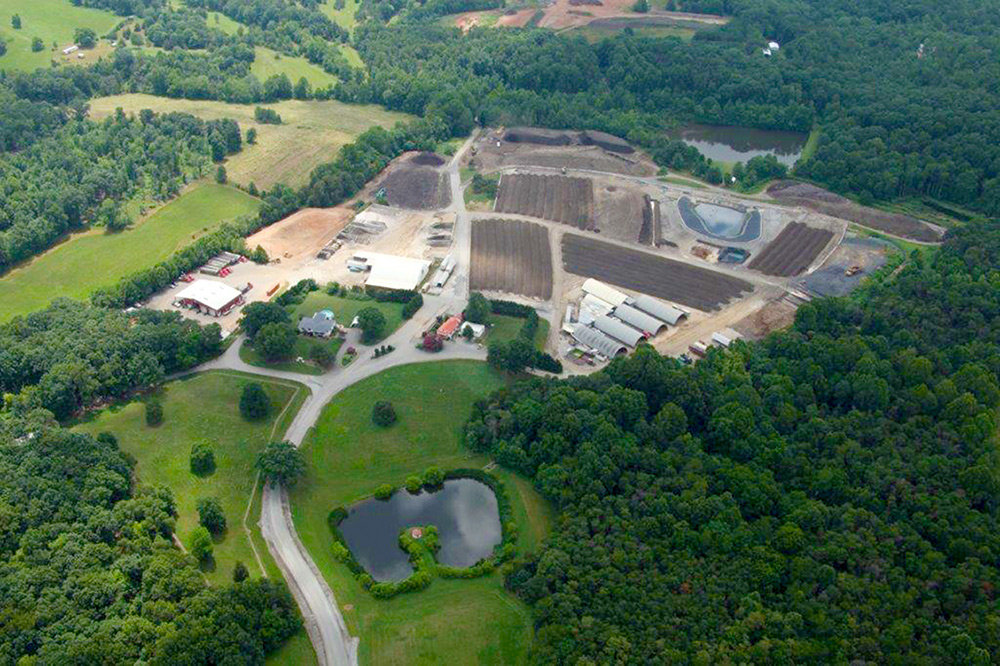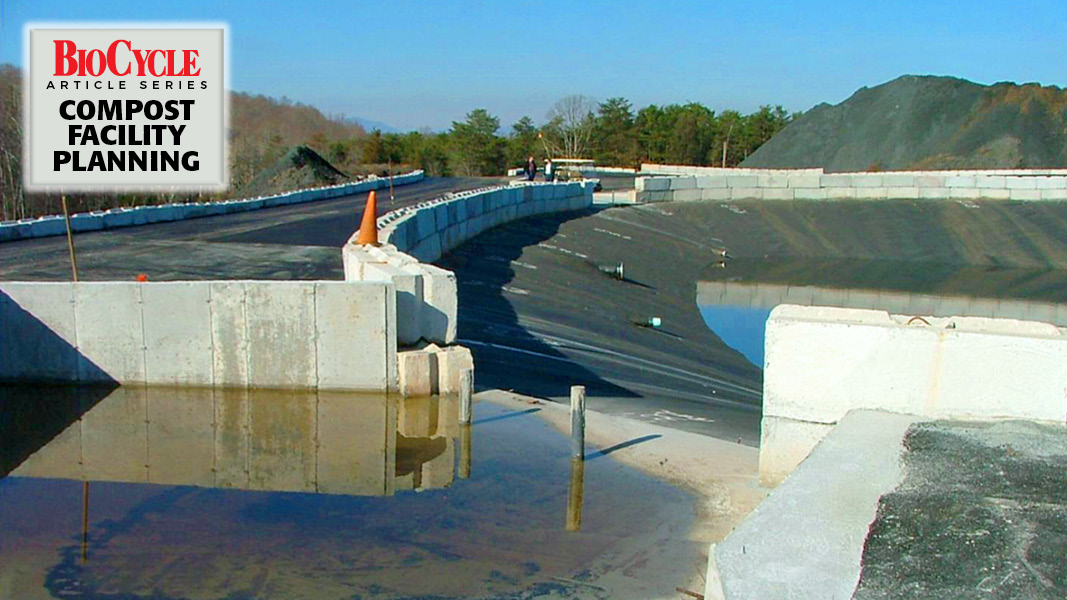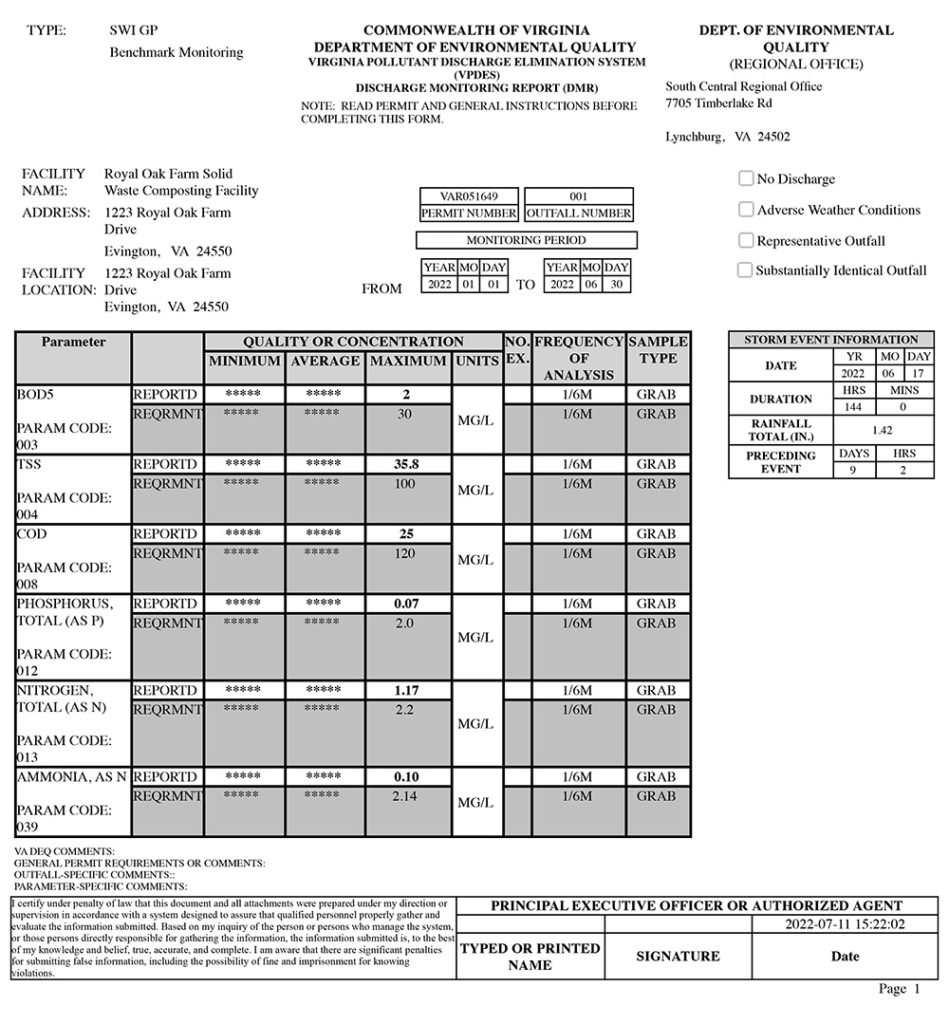Top: Storm water collection pond at Royal Oak Farm.
Craig Coker
Sixth of a series of articles on issues to consider when planning a new composting facility in the U.S.
Planning a new merchant organics recycling facility requires considerable thought and investigation. As the old adage goes, “Proper prior planning prevents poor performance.” This facility planning series is oriented to helping you think through the aspects of proper prior planning. Part I dealt with how to develop a Waste Capture Plan. Part II covered methods to assess the markets’ potential to absorb your compost and/or soils products. Part III looked at how to figure out how much room you would need for your new composting facility. Part IV explored how to evaluate different composting approaches or methodologies. Part V examined issues to consider when looking at possible sites for a composting facility. This article discusses the various local and state-level approvals and permits that will likely be needed.
Local Government Approvals And Permits
There are two types of local government sign-offs you will likely need: upfront approval of the site from a land use and zoning perspective, and post-design permits for buildings, construction-phase sediment and erosion control and storm water management. This article focuses on upfront approval of the site. In some states, the local government must include your proposed facility in their 10-year Solid Waste Management Plan and get that Plan approved by state regulators (this will add 6 to 9 months to your project’s gestation period).
Land use and zoning laws involve the regulation of the use and development of real estate. Zoning regulations and restrictions are used by municipalities to control and direct the development of property within their borders. Since New York City adopted the first zoning ordinance in 1916, zoning regulations have been adopted by virtually every major urban area in the United States.
The basic purpose and function of zoning is to divide a municipality into residential, commercial, and industrial districts (or zones) — for the most part separate from one another with the use of property within each district being reasonably uniform. Within these three main types of districts, there generally will be additional restrictions that can be quite detailed.
Land-use regulation is not restricted to controlling existing buildings and uses; in large part, it is designed to guide future development. Municipalities commonly follow a planning process that ultimately results in a comprehensive or master plan, and in some states the creation of an official map for a municipality. The master plan is then put into effect by ordinances controlling zoning, regulation of subdivision developments, street plans, plans for public facilities, and building regulations.

Royal Oak Farm solid waste composting facility in Evington, Virginia. Photos courtesy of Royal Oak Farm.
Zoning approvals can be classified as “permitted by right,” “permitted by variance,” “permitted subject to Special Exception,” “permitted subject to a Conditional Use permit,” and “not permitted.” A shoe store operating in a commercially-zoned district is an example of “permitted by right,” as is farming in all agricultural zones (Coker, 2014). A variance is a license to do some act contrary to the usual rules, often justified by existence of hardship. Variances can be use-based (e.g., a dentist office in a residential area) or area-based (e.g., a garage closer to the property line than ordinance allows). A special exception is a permitted use under the zoning ordinance so long as the conditions for its availability stated in the ordinance are met and the proposed use does not seriously infringe upon the health, safety and welfare of the community (e.g., a day care center in a commercial district). Special exceptions often require special criteria to be met (e.g., fencing of play areas at the day care center).
CUPs For Composting And AD Facilities
A land use subject to a Conditional Use Permit (CUP) is a Special Exception that has to be approved by a governing body. This is the approvals process that most composting and anaerobic digestion (AD) facilities go through. CUPs give local governments a sense of control over the application, and as most governing body deliberations are public events, CUP hearings give neighbors and other affected parties a voice in the approval process. CUPs can be (and have been) revoked if the facility operation consistently violates one or more conditions of the permit. They can impose reasonable conditions and safeguards. Conditions that have been imposed on composting facilities have included no work on Sundays before 12 noon, no truck traffic on certain streets, and all windrows must be kept covered by fabric covers, among other requirements.
The zoning approval process for CUPs usually requires an application, a scaled site plan, and a description of proposed facility operations. The application and supporting documents are reviewed by zoning staff and in many cases, are reviewed by a standing committee that includes representatives from utilities, public works, transportation, and fire marshal’s offices. The applicant provides answers to questions and provides other requested documentation. The application then goes to the community’s Planning Commission for approval, which usually requires at least one public meeting where the public can make comments on the application. Following Planning Commission approval, the application goes to the elected governing body of the community, where another public hearing is held. The governing body either approves the Planning Commission’s approval, or remands (sends back) the application to the Commission with questions or issues to be addressed. The entire process can take about four to six months, although it can be somewhat faster in smaller communities.
Waste Management Activity
Composting (or digestion) facilities are very rarely defined in local zoning ordinances and rules. As a result, land use planners and zoning officials tend to classify it as a waste management activity, which is usually a highly restricted land use. One approach that I have successfully used was to get a zoning text amendment passed, which specifically defined and allowed composting in a particular zoning category.
Another issue that often occurs is that zoning ordinances make no distinction between large-scale commercial and small-scale community composting, which is viewed as an impediment to the expansion of community-scale composting facilities (ILSR, 2014). To address this issue in Ohio, the Ohio EPA prepared the document, “Urban Agriculture, Composting and Zoning: A Zoning Code Model for Promoting Composting and Organic Waste Diversion Through Sustainable Urban Agriculture,” in response to various requests for guidance coordinating the state’s composting regulations and local zoning codes. The document is meant to serve as a guide for planners, zoning officials, municipalities, community groups and all urban agriculture stakeholders in developing local zoning that encourages the establishment of community gardens and composting activities in compliance with related local land use and state environmental regulations (Arroyo, 2012).
Even attempts to expand on-farm composting of food scraps brought in to the farm from commercial and residential sources has run into the buzzsaw of zoning opposition. In 2015, the Maryland Department of Environment adopted new composting regulations that exempted four types of on-farm composting from state regulations as they were considered “an adjunct to farming.” Howard County, a suburbanizing county between Baltimore MD and Washington DC adopted an ordinance to regulate wood mulch and composting activities, which added extensive additional conditional uses on any on-farm composting operation (Johnston, 2017). Public hearings about the County’s ordinance degenerated into heated arguments that lasted hours. Some of the more disturbing testimonies included one claiming to link composting/mulching to drinking water contamination and cancer, and a local Sierra Club representative expressing disbelief and disgust at animal waste being included in compost.
The U.S. Composting Council (USCC) has developed a Model Composting Ordinance (Zbinden, 2019). The intent, states the document’s Introduction, “is to provide baseline ordinance language collected from research into existing zoning ordinance and land use classification tables across the U.S. as a ‘best practice’ for zoning ordinances, to help municipalities who do not have ordinances in place to address applications for industrial (also often called commercial) composting, small-scale (also often called ‘community’ or ‘decentralized’) composting, and on-farm composting. The assumption is that each community will apply its own geographic, cultural, political and environmental situation to the template and modify it as needed. To assist with this process, this document includes background discussion to assist with decisions in areas covered by the ordinance.”
Getting local approval for your planned composting facility is generally required before state environmental regulators will even consider, much less approve, any permit application for a solid waste composting permit. The key to success is to pack a lot of patience, be absolutely factual and documented about everything, and recognize that you only need a majority vote on the Planning Commission and City/County Council to win approval.
State Environmental Permits
Now that you’ve secured your local approvals (and washed off the tar-and-feathers from that last public hearing), you will need to apply for state composting permits. There are generally three types of permits you will need: a solid waste composting permit, an operations-phase storm water discharge permit, and, less frequently, an air pollutant emissions permit (yes, composting facilities do emit air pollutants, albeit in very small quantities usually).
All states have regulations now that guide the development, design and operation of solid waste composting facilities, although some are more rigorous than others. There are several webpages that document where to find the regulations in each state, such as the USCC’s site, and the site available from the Institute for Local Self-Reliance. I realize reading state regulations is slightly more exciting than watching paint dry, but you should make an effort to understand your state’s regulations at a very great level of detail and understanding.
Until the mid 2000s, most state regulations and permit requirements for solid waste composting facilities treated the applications as if they were applying for a new sanitary landfill as they had no other regulatory guiderails. The permit we got for the 60,000 tons/year turned windrow facility at Royal Oak Farm in Virginia in 2006 was the first solid waste composting permit issued by the Virginia Department of Environmental Quality and the permit application preparation and submittal costs were in six figures. Since then, many states have updated their regulations to focus on registrations and “permits-by-rule” rather than full-blown permits. The USCC has a Model Composting Regulations template, which has been used by some states as a guiding document as they have revised their regulations.
Most state regulations now are “tiered,” i.e., they assign more rigorous siting, design and operations requirements to feedstocks with higher “pathogenicity” (e.g. sewage sludge is regulated more heavily than yard wastes) and to larger scale facilities — a recognition that on-farm and community composting facilities, with their smaller throughputs and footprints, are not a major environmental hazard. As it can be an expensive and time-consuming hassle to upgrade a permit to handle more heavily-regulated feedstocks, your Waste Capture Plan (see Part 1) should anticipate that potential so you apply for the right facility size and feedstock class. The more rigorous design standards for higher pathogenicity feedstocks have been applied to food waste composting in some states. In New Jersey, for example, a food waste composting pad must meet an impermeability standard of 1 x 10(-7) centimeters per second, which is the impermeability standard protecting groundwater from a hazardous waste landfill.
Storm Water Management Permit
Storm water runoff from operating composting facilities is regulated by states. There are two types of storm water discharge permits — individual and general discharge. Of the two, the general discharge permit is preferred. Individual permits contain effluent discharge limits, expressed as monthly averages and daily maximums, which require intensive (and expensive) monitoring and reporting for compliance. Avoid an individual discharge permit if you can.
General storm water discharge permits were developed by U.S. EPA under the Clean Water Act’s National Permit Discharge Elimination System (NPDES) program as it made sense to group the storm water discharges from facilities in the same Standard Industrial Classification (SIC) code as similar to one another. EPA has delegated authority to most states to administer the program. Currently, solid waste composting facilities are lumped together under the Agricultural Chemicals sub-sector, SIC Code 2875 – Fertilizers, mixing only (this may change in the future once the composting industry gets its own North American Industrial Classification System (NAICS) code). NAICS is the successor to SIC.
An Industrial General Storm Water Discharge Permit requires the permittee (you) to prepare and implement a Storm Water Pollution Prevention Plan (SWP3) and to do periodic benchmark monitoring against that state’s defined storm water quality criteria. These criteria vary from state-to-state, for example, in Virginia, composters must monitor for biological oxygen demand, total suspended solids, chemical oxygen demand, total phosphorus, total nitrogen, ammonia-nitrogen and, in some watersheds, Escheria coli bacteria. You have to take a grab sample of runoff discharging from your composting facility property (at the most downstream point) and report it on a discharge monitoring report (Figure 1). Your sampling must occur during a rainfall event producing a discharge and at least 72 hours must have passed since the previous discharge-inducing storm (to capture the “first flush” of runoff pollutants). If you have an exceedance, you are supposed to more rigorously enforce the elements of your SWP3. In some states, repeated violations of benchmark standards allow states to switch your permit from a general discharge permit to an individual discharge permit, which you will want to avoid.
Air Emissions Permit
The third category of emissions permit you might need is an air emissions permit, which is, by far, the most confusing set of federal and state regulations. Federal regulations require each major source of air pollutant emissions to obtain an “operating permit” (known as a Title V permit) that consolidates all of the air pollution control requirements into a single, comprehensive document covering all aspects of the source’s air pollution activities. Very few composting facilities qualify as “major” sources of air pollutants. A State Operating Permit (SOP) is most often used by stationary sources to establish federally enforceable limits on potential to emit to avoid Title V permitting and/or major source Maximum Available Control Technology MACT applicability. When a source chooses to use a SOP to limit emissions below major source permitting thresholds, it is commonly referred to as a “synthetic minor” source. I told you this is confusing.
Air pollution permits are also required for businesses that build new pollution sources or make significant changes to existing pollution sources. These are sometimes referred to as “preconstruction” or “new source review” permits. Operating permits document how air pollution sources will demonstrate compliance with emission limits and with other “applicable requirements” such as work practices (e.g., periodically watering a dirt road to prevent dust emissions). Operating permits also document how air pollution sources will monitor, either periodically or continuously, their compliance with emission limits, and all other applicable requirements on an on-going basis.
The permitting process starts with an evaluation of the “potential to emit” (PTE). This is defined as the maximum capacity of a stationary source to emit under its physical and operational design. The calculation is based on uncontrolled air emissions emitted 24 hours per day, seven days per week. If the PTE for one of the criteria or hazardous air pollutants exceeds regulatory thresholds, a permit is required. PTE calculations can be based on actual emissions measurements or on referenceable literature citations.
Literature values are often used as actual emissions testing is very expensive, but there is a downside. For a proposed 115,000 tons/year compost-covered aerated static pile (CASP) source separated organics composting facility in Minnesota, a PTE analysis of Volatile Organic Compound (VOC) emissions from the facility is required to use an emissions factor (3.58 lbs. of VOC per ton of material in the CASP bunkers) that the California Air Resources Board reported in one of their analyses of VOC emissions from windrow composting of green waste — even though more recent field emissions testing at a food and yard waste CASP facility in Napa CA showed a much lower VOC emissions rate (0.3 lbs./ton). Minnesota regulators insisted that the higher emissions factor be used in the PTE analysis as it was a referenceable number in a regulatory document, not unpublished data from a technology provider. In the case of this Minnesota facility, the biofilters treating the air from the CASP when operated in negative air mode will become permitted “air pollution control devices” (APCDs), as will the biolayer over the CASPs when operated in positive mode.
Air emissions permits come in two parts: a “permit to construct” and a “permit to operate.” You cannot begin substantial construction of an APCD until the air permit-to-construct is issued (you can do some minor site work, like clearing and grading). And you cannot get a permit-to-operate until you have proven, via source testing, that your APCD is indeed removing pollutants at the removal efficiencies you indicated in your permit application. Source testing to prove pollutant removal efficiencies is expensive.
In some cases, air emissions permits are needed for large horsepower diesel-fueled machines, particularly grinders, although other equipment that is not moved very often may fall under permitting rules (truly mobile equipment, like trucks, are exempt from permitting). This can lead to restrictions on operating hours per day in order to limit emissions to the applicable “pounds per day” permit limit.
Dealing with local and state approval processes can be frustrating, time-consuming and expensive. But complying with all these rules is what separates professional composting from the “bottom-feeders” that have plagued this industry for years.
Craig Coker is CEO of Coker Composting & Consulting near Roanoke VA and is a Senior Editor at BioCycle CONNECT. He can be reached at ccoker@cokercompost.com.














